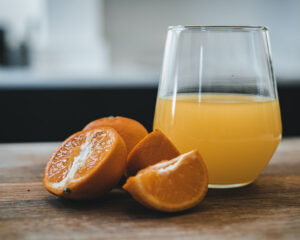ORANGE JUICE

Orange juice (OJ) is an iconic healthy breakfast drink. Every TV show I ever watched with scenes over a breakfast table featured a glass of OJ. Juice was natural and wholesome, much like the TV families depicted. Then came the juice bar phenomenon in which you could order bespoke blends of fruit and vegetable juices, typically in very large serving sizes and consumed with a plastic straw (which are of course terrible for the environment). This planted the seed of suspicion that fruit juices were not the wholesome healthy beverage we previously believed. The criticism of fruit juices was primarily about rising obesity rates, and the finger of blame pointed at sugars – even natural ones. The World Health Organisation (WHO) now includes fruit juices in its definition of ‘free sugars’ to limit, and this was the pin in the balloon for OJ.
What are the positives of 100% orange juice?
100% orange juice:
- is rich in vitamin C (and helps the absorption of iron in foods consumed with it);
- is rich in folate;
- contains polyphenol antioxidants (including hesperidin), and is a major contributor of population flavonoid intake (1,2);
- contains beta-carotene, a carotenoid antioxidant;
- has a low Glycemic Index (GI), and a neutral effect on blood glucose control and insulin sensitivity (3,4);
- is associated with reduced chronic disease risk, including metabolic disease (5) and cognitive decline in ageing (6);
When it comes to body weight, any association between high sugars intake and obesity are not observed when 100% juice is consumed in typical amounts (7,8). Additionally, in children and adolescents, there is no association between 100% fruit juice and body weight. (9) Another criticism of juices are their acidity and the risk to teeth; however, a review found no association between 100% orange juice and dental erosion or dental decay (10).
Many of the potential risks of consuming orange juice can be mitigated by not overconsuming them. A serving of fruit juice in Australia is 125mL, and young children are best offered juice diluted 1:1 with water. Fruit juices should not be offered before 12 months of age. (11)
Orange juice is an enjoyable nutrient-rich beverage and a much better choice than soft drinks, especially for teens who tend to drink soft drinks in the largest amounts, but have high nutritional needs for growth. Orange juice contains natural sugars, but this does not mean they are harmful or should be avoided. Enjoy OJ in moderation, and not instead of whole fruit that offers beneficial dietary fibres and satisfaction of hunger.
| 100% Orange Juice (commercial) | |
| 4.5 Health Stars | |
| Glycemic index (average) | 48 |
| Serving size – ½ Cup (125 mL or 4.4 oz) | |
| Kilojoules | 145 |
| Calories | 35 |
| Protein (g) | 1.0 |
| Fats (g) – total | 0 |
| Includes: – Saturated fat (g) | 0 |
| – Monounsaturated fat (g) | 0 |
| – Polyunsaturated fat (g) | 0 |
| Saturated : unsaturated fat ratio | N/a |
| Carbohydrates (g) – Total | 7.5 |
| Available (Includes): | 7.1 |
| –Natural sugars (g) | 7.1 |
| –Natural starches (g) | 0.0 |
| –Added sugars (g) | 0.0 |
| –Added starches (g) | 0.0 |
| Unavailable (Includes): | 0.4 |
| –Dietary fibre (g) | 0.4 |
| Sodium (mg) | 3 |
| Potassium (mg) | 190 |
| Vitamin C (mg) | 88 |
| Folate (ug) | 67 |
| Glycemic load (g) | 3 |
| Diabetes exchanges | 0.5 |
| Ingredients: Oranges |
Source: Australian Food Composition Database and www.glycemicindex.com
Read more:
- Australia’s health 2018: Fruit and vegetable Intake. Australian Institute of Health and Welfare, 2018.
- Zamora-Ros and colleagues. Estimated dietary intakes of flavonols, flavanones and flavones in the European Prospective Investigation into Cancer and Nutrition (EPIC) 24 hour dietary recall cohort. Br. J. Nutr. 2011.
- Wang and colleagues. Effect of fruit juice on glucose control and insulin sensitivity in adults: A meta-analysis of 12 randomized controlled trials. PLoS ONE 2014.
- Murphy and colleagues. 100 % Fruit juice and measures of glucose control and insulin sensitivity: A systematic review and meta-analysis of randomised controlled trials. Journal of Nutritional Science, 2017.
- Dourado and Cesar. Investigation of cytokines, oxidative stress, metabolic, and inflammatory bio- markers after orange juice consumption by normal and overweight subjects, Food Nutr., 2015.
- Kean and colleagues. Chronic consumption of flavanone-rich orange juice is associated with cognitive benefits: an 8-wk, randomized, double-blind, placebo- controlled trial in healthy older adults. Am. J. Clin. Nutr. 2015.
- Rampersaud. 100 % Fruit juice: perspectives amid the sugar debate. Public Health Nutr. 2016.
- Chiavaroli and colleagues. Important food sources of fructose-containing sugars and adiposity: A systematic review and meta-analysis of controlled feeding trials. Am J Clin Nutr. 2023.
- O’Neil and Nicklas. A review of the relationship between 100 % fruit juice consumption and weight in children and adolescents. Am J Lifestyle Med, 2008.
- Liska and colleagues. 100% Fruit Juice and Dental Health: A Systematic Review of the Literature. Front Public Health. 2019.
- Joint Position Statement on Interdisciplinary collaboration between Accredited practising Dietitians, Nutrition and Oral Health Professionals for Oral Health and Nutrition. Dietitians Australia and Dental Health Services Victoria, 2021.








